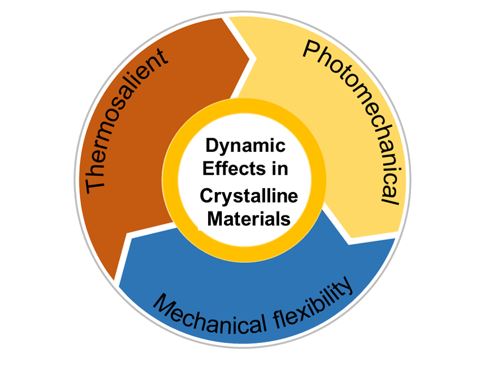Video Article Open Access
Personal Perspectives on Dynamic Crystals
Jagadese J. Vittal
Department of Chemistry, National University of Singapore, Singapore 117543, Singapore
Vid. Proc. Adv. Mater., Volume 3, Article ID 2203261 (2022)
DOI: 10.5185/vpoam.2022.03261
Publication Date (Web): 21 Jul 2022
Copyright © IAAM
Graphical Abstract

Abstract
The physical and chemical properties of the solids are directly related to their crystal structures. The crystal engineering tools can be used to modify and fine-tune these properties. It is possible to design organic crystals, coordination polymers CPs) and metal-organic framework (MOF) materials with desired physical properties like solubility, crystal bending, guest and gas sorption, storage, separation and transportation, ion exchange, catalysis, magnetism (magnetic ordering, spin crossover), conductivity, optics (multi-photon upconversion, luminescence and sensing, birefringence), negative thermal expansion and processability. As more and more exotic new crystalline materials are made, unexpected, unusual and unpredictable properties have been discovered. In our laboratory we have encountered a number of interesting properties such as structural transformations due to solvent exchange, change of composition and dimensionality due to grinding, unexpected photoreactivity of organic crystals and transition metal complexes and centrosymmetric crystals showing second-order non-linear optical properties.
The traditional perception of crystals being rigid, hard, and brittle is changing ever since the discovery of mechanically responsive crystals. External stimuli induced structural changes at the molecular level has been successfully manifested to visually impressive dynamic effects in the crystal bulk. For the past few years, macroscopic dynamism has been conveniently demonstrated in response to the external stimuli such as light, heat, mechanical force, etc. With the appearances of plenty of reports on stimuli responsive crystals, this dynamic research area has emerged as a major playground for solid state chemists. Based on the understanding of structure-property relationship, mechanically compliant crystalline materials can be designed by applying crystal engineering principles, which were once serendipitous. This talk presents the recent scientific developments in the photoreaction involving [2+2] cycloaddition reaction, dynamic and mechanical properties of crystalline materials in our laboratory which has been mostly limited to organic crystals. In the quest for developing multifunctional actuating materials, metal complexes and CPs have the potential to be leading candidates. Previously thought serendipitous dynamic effects can be rationally induced in mechanically compliant crystals after understanding structure-property relationship at the molecular level.
Keywords
[2+2] cycloaddition reaction, dynamic crystals; coordination polymers; metal-organic frameworks; metal complexes.
References
- Rath, B.B.; Vittal, J. J.; CrystEngComm., 2021, 23, 5738.
- Rath, B.B.; Vittal, J. J.; Chem. Mater., 2021, 33, 4621.
- Rath, B.B.; Gallo, G.; Dinnebier, R.E.; Vittal, J.J.; J. Amer. Chem. Soc., 2021, 143, 2088.
- Rath, B.B.; Vittal, J. J.; J. Amer. Chem. Soc., 2020, 142, 20117.
- Rath, B.B.; Kole, G. K.; Morris, S. A.; Vittal, J.J.; Chem. Commun., 2020, 56, 6289.
Biography
J.J. Vittal after his BSc (University of Madras) and MSc (Madurai University) received PhD from Indian Institute of Science, Bangalore in 1982. After working as a postdoctoral fellow at the University of Western Ontario, Canada, he managed the X-ray service facility. In 1997, JJ accepted a faculty position and moved to the National University of Singapore (NUS). He is currently an Emeritus Professor at NUS from 2021. He held a World Class University Chair Professorship at the Gyeongsang National University, Jinju, South Korea (2009-2013). JJ’s current major research interests include various aspects of coordination polymers & metal-organic frameworks, crystal dynamics and solid-state photoreactivity. He co-authored ‘Crystal Engineering – A Textbook’ with Desiraju and Ramanan. He also edited two more books on Crystal Engineering. He is a Fellow of Royal Society of Chemistry, Singapore National Institute of Chemistry and Indian Chemical Society. JJ won various awards including Chemical Research Society of India Medal (2020), Indian Chemical Society G.V. Bakore Memorial Award (2019), Outstanding Chemist Award, NUS (2014), CRISP Award, NUS (2013), Outstanding Research Award, NUS (2011), Outstanding Scientist Award, NUS (2007), ISCAS Bronze Medal (2001) and Kharkanawala Memorial Award (1980). His research profile was highlighted in Angewandte Author Profile (2014), was an Erudite Scholar-in-Residence India (2011) and interviewed for the sceptical chymist in the nature Chemistry Blog (2011). He holds editorial board membership in several journals including ACS Crystal Growth & Design. He was the founder and organizing committee member of Singapore National Crystal Growing Challenge (1997-2016). JJ published ~550 original papers, reviews and book chapters. Google Scholar Citations: ~23,500 citations and h-index, 76. According to the recent C-score (composite indicator for career-long impact), JJ ranks 83 out of 57598 researchers in the field of Inorganic & Nuclear Chemistry in the world.
Video Proceedings of Advanced Materials

Upcoming Congress



